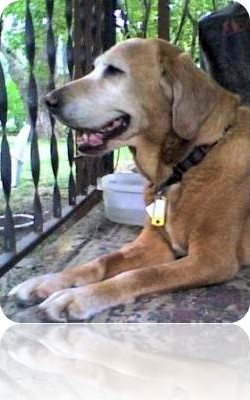

 |
 |
||
|
|||
| Home | |||
 |
|
| Saunie - Complex Disease/Complex Pain | |
In many ways Saunie was a typical 12 year old large breed dog; she had diabetes, she was feeling more pain and stiffness as time went on, her back legs were becoming weak, and she had cancer. With all that was going against her, her Mom was losing hope. After all, her pain medication weren't helping much; her quality of life was gradually eroding away. What wasn't typical was the fact that Saunie's Mom worked at a primary care veterinary hospital. The practice's veterinarian held no more hope for Saunie; all known options had been exhausted. Rather than letting Saunie suffer, it was suggested that Saunie needed to be put to sleep. The appointment was made for Saturday morning; Saunie's Mom heard about our practice and called the day before; we booked an immediate appointment. When we met Saunie and her Mom we were struck by the deep bond of love between the two and their shared charming dispositions. We took inventory of Saunie's disease related concerns and listed her Mom's goals. Although Saunie's problems were complex and interwoven into a daunting fabric, we had good answers for each of the elements and high expectations that we could reach the goals.
Our shared goals were to improve quality of life, strengthen the rear legs, and alleviate her pain. Saunie's medication strategy included an oral cartilage protectant and an injectable cartilage protectant/disease modifier. A non-steroidal anti-inflammatory (NSAID) medication was included to take advantage of its pain relieving potential and its anticancer potential. An NMDA antagonist and a calcium channel blocker were teamed with a mild opioid pain reliever to broaden her pain relief. Acupuncture sessions were initially once weekly and physical rehabilitation therpay appointments were initially twice weekly. Within a few short weeks Saunie was much happier; more comfortable, better balance, strength, and stamina. Acupuncture and physical rehab was gradually spaced further and further apart. Saunie made continued progress; moving more comfortably, showing more energy, handling stairs more capably, resuming her walks around the neighborhood. Saunie loved her PRT visits with Stephanie so much she "insisted" on coming in every Friday for a tune up. While there were some ups and downs during her treatment, medication adjustments allowed Saunie to maintain an excellent quality of life throughout her care. The time came when Saunie suffered a precipitous decline. At that point it was clear to all that it was Saunie's time. Many tears were shed the day we had to let her go. But many were shed for joy over the 11 month life extension that Saunie had so thoroughly enjoyed with her family. |
|
|
|
| Patient Case Reports | |||